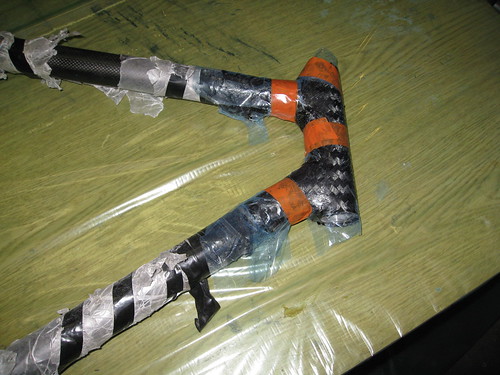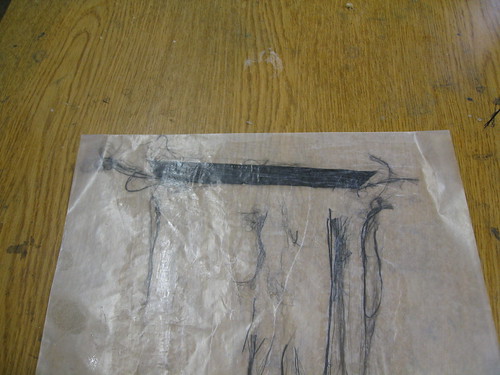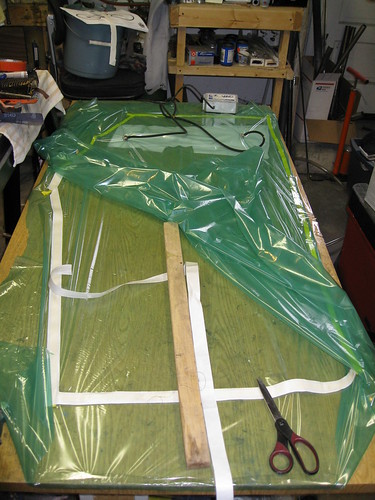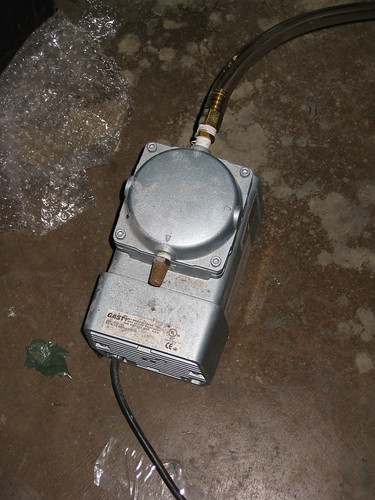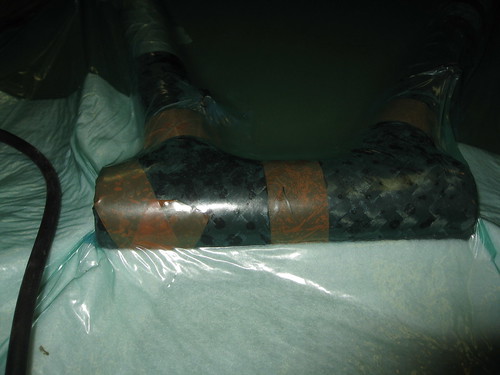The 'day' job has been getting in the way of real work. Then I discovered I was a bit short on some supplies, which are now on order. Consequently, there hasn't been much work done on the carbon frame, nor posts associated with same.
Perhaps now would be a good time talk some theory, to fill in the time-gap and maybe make you better informed consumers.
There is a lot of misinformation out there about frame-building, frame materials, and frame design. I'm not going to try to address all of that here. But all of these topics will be touched on, at least a little.
Carbon fiber is a great material for building frames because it can be formed into light strong structures that fit (literally size-wise) into the requirements for a bicycle frame. Of course, Aluminum, Steel, and Titanium all fit this brief too. As far as I'm concerned, there is no hierarchy of good, better, best among these materials. They all work.
I don't work with Aluminum or Titanium because I don't know how to Tig weld, and don't have a Tig welder (quite an expensive setup). If the facts were otherwise, I'd consider working with both of these materials. However, they're not, and I don't have time to change the facts, so I stick to Steel and Carbon Fiber.
Carbon builds up to a low-weight frame easily. A very-low-weight frame takes a bit more work. But a simple question, that is worth asking, is: How low a weight do we need? It might be fun to build yourself a bike that is too light to race (legally). But how practical is that? The simple answer is: Not very. Very light is expensive, less durable, and at some point loses functionality. A well made and designed bike, that falls between 15 and 17 pounds, is capable of winning in the Pro Tour. And we can pretty easily build to this weight at a price that many riders are willing to pay.
Nonetheless, some riders want to be nearer to 15 (or less) than 17 pounds. And they don't want to achieve their goal by using $6000 wheel-sets. Carbon can help us meet that requirement more easily than does steel. While I enjoy the aesthetic of steel frames, I've come to also appreciate the aesthetic of carbon frames. It's a different flavor, not necessarily better or worse. And as a builder, I'm learning how to leverage it to create a beautiful bike.
In the press, you will find all sorts of claims about special forms of carbon fiber and uniquely shaped tubes. Also there is discussion of tube to tube (T2T) versus monocoque versus lugged, and frankly it gets tedious to read after a while. As a rider, it doesn't really matter if your bike is T2T, monocoque or lugged. Each method works well, and produces competitive frames. The palmares of each of these frame types is extensive and up to date.
As a side note, the term monocoque is probably misused in this application. Arguably, any tubular bike frame is a monocoque structure. In the case of carbon frames, the term is generally used to indicate that a frame is laid up and cured as one piece. Generally this isn't how carbon frames are made. Instead, most of the so-called monocoque frames are build a triangle at a time.
Further, there frames, such as Trek, that look otherwise, but are essentially lugged frames. Individual parts are made, with male/female joints on the end, and the parts are then glued together. Careful paintwork and decaling helps to hide the joints.
But what about the types of carbon fiber? Here too, it's hard to decipher the importance of this information for a rider. Everyone claims that they use 'high-modulus' carbon fiber. Via that term, they are implying that they have selected form of carbon fiber that is particularly stiff. And we all know that stiff bikes are good, right?
Actually, its not clear how stiff a bike needs to be to efficiently transmit your power to the rear wheel. It's also not entirely clear where the stiffness is needed (except in so far as it protects the frame from fatigue failure). Many will quarrel about this point, but after researching the issue, I'm convinced that there is a material divergence of opinion in the scientific and engineering communities regarding this point. So I'm not willing to say that 'stiffer is better'.
But lets say we don't want a noodle (while remembering that Alan bikes were noodles that also won all sorts of championships). All else being equal, a bike made of fiber with a higher modulus of elasticity will be stiffer.
Unfortunately, terms such as 'high modulus' aren't very precise descriptors. From what I can tell, most carbon fiber used in bicycle frames varies between what could loosely be called the high end of low modulus (LM) and the middle range of intermediate modulus (IM). I hope that folks don't find that to be too disturbing an observation - it doesn't change how CF bikes perform.
You may wonder why builders aren't all using very high modulus CF? After all, we want to make our bikes stiff, don't we? Generally, the answer is 'yes' the manufacturers are trying to make their bikes stiff. They are also trying to make them strong. And for many families of carbon fiber there is nearly an inverse relationship between strength and stiffness. If the fiber is too stiff, it is less strong and may also be more brittle (so it doesn't hold up well to shocks). A bike frame needs to be made of a material that is strong and can handle shocks, so a number of HM carbons just aren't appropriate.
This is the first way in which manufacturer claims, should be taken with a grain of salt, regarding HM carbon fiber.
Consider also, these claims almost never specify how much of the CF in a frame is HM. And now we have two ways by which the term High Modulus carbon fiber is misleading in various marketing and editorial material.
There are a couple of ways that a material can be made to act more stiff, regardless of it's Young's Modulus. First of all we can use more material. The wall thickness can be increased, making the tube stiffer and stronger. When we're trying to reduce weight, this may not seem desirable. But consider that we need enough material to provide the required strength for a job, and this volume of material may prove to offer sufficient stiffness for the job at hand.
In the case of bicycle tubes, we can also increase their diameter, further leveraging the stiffness imparted from their being a monocoque. Naturally, this approach has limits determined by the physical space available. Probably the biggest limit, for tubing diameter, however, is that a certain minimum wall-thickness is necessary to maintain the integrity of the tube. This is true regardless of the material which we use. And in my experience, light frames, of any material, explore the limits of wall thickness of that material. In other words, we may not be able to get enough strength, in a tubular form, with an amount of material that merely offers sufficient stiffness for our goals.
I remember a reading a review where the manufacturer proudly described how his tubes could be squeezed by hand, suggesting that this was proof of how they would absorb shock. My personal reaction was that there was minimal wall strength causing me concerns about the durability of such a frame. BTW, I haven't heard that manufacturer continue to make such claims, leading me to believe that they may have backed away from this approach.
If you do a search online for carbon fiber, there are a number of sources from which to purchase small quantities of CF. Heck, there are a number of sellers on ebae alone. Rarely, however, do these sources reveal much about the characteristics of the materials that they are selling. Sometimes claims are offered regarding commercial or aerospace grades. Often there is a description of the weave, which is merely a matter of style. Generally the the weight per square yard and dimensions are provided. The weight is interesting because it speaks directly to how much of this stuff there is - which leads right into the question of strength. But, even sources supplying experimental aircraft builders don't provide the modulus of elasticity, the modulus of strength, much less the manufacturer and model code of the actual carbon fiber.
When you go to any lumber yard, its possible to specify your materials by a number of variables that indicate its suitability/strength for your use. But most of the CF sources, selling in lots of less than 100s of yards, don't offer this basic service. Leaving their users to either overbuild for safety, or limit their use of CF to cosmetic purposes.
After a long period of time, I've found some sources which allow me to spec CF materials properly. They either provide the technical specs, or provide manufacturer and model info so I can confirm these myself. This is important, and anyone who wants to experiment with CF building needs to have this information if they want to achieve repeatable results.
Back in the archives are posts about some of the fabrics I use. I'm going to repeat some of that here, because traffic is up and many folks may never search back that far through the archives.
Uni, uni, uni, uni, uni-directional carbon fiber. Many we hear the term a lot. Everyone reading this probably knows that the strength of CF is along the length of the individual threads. Moreover, that it is very much stronger in tension than compression. And that the proper orientation of the fiber is necessary to give strength in the direction of forces in any one area of a bike frame.
If things were a simple as this, CF bike frames wouldn't work. The frame and its tubes are made of layers of CF. Generally a layer is made of uni-directional CF, that is, CF where the fibers run in parallel. But the main part of a tube may only have 5-6 layers of CF, with the majority running either + or - 45 degrees from the axis of the tube, and a little running parallel to the axis. I can guarantee that the forces faced by the tube don't all align with these three directions.
Think of a sailboat tacking into the wind. A force pushing in one direction can move an object to ultimately move in the opposite direction. Similarly, the various directions (vectors) of force encountered by the tube can be channeled into the fibers going in multiple directions, and successfully resisted - allowing for the creation of tubes with a very limited set of alignments of CF. If we had to have fibers arranged for all the forces experience, we would need many more layers of CF, and therefore much more weight.
Within joints, things get a little more complicated, but one of the complications is that the physical shape of the joint can interfere with placing fibers in the desired orientation. For example: It might be nice to run a fiber across the top of the BB, and then up either the seat tube or down tube. But this generally leads the CF around a sharp corner, even if a fillet has been built up in that corner. CF doesn't like sharp corners, and doesn't provide good strength around them. Much better is to run the CF at an angle across the BB, and then wrap the respective tube in a spiral. This reduces the bend in the fibers, and essentially requires another layer in the reverse direction. Then the two together resist the forces that led us to want the fiber to go straight up the tube. And, these spiraled layers also resist torque or twisting movements in the tube and joint. Cool, huh?
Next time someone talks about their proprietary layups, or trade secrets, take it with a grain of salt. It isn't all rocket-science.
In a similar vein, how about those seat/down tubes that flare out to the full width of the BB? Having never cut one of those apart (other riders are very sensitive, it seems, about my experiments), I can only guess. But my guess is that the cup or cylinder in which the BB is affixed, has an internal fillet which allows the fibers to shift directions to parallel the axis of the BB axle.
Now the extra width is supposed to make this junction stronger and stiffer. Does it? Again, I can only speculate, but suspect that the impact is this design is minimal. For any form of bending, there is a question as to where the bending occurs. If the bottom bracket is made sufficiently rigid, it is likely that bending forces move up the respective tubes to a less rigid location. A chain is only as strong as it's weakest link, eh? And without further reinforcing the tubes away from the joint, reinforcing the joint is apt to offer minimal gains.
This is shaping up into a pretty good rant, and there's more ground to cover, including some discussion of the materials that I use. Given the length of the post, combined with the fact that Comcast is acting up today and the inter-tubes aren't acting happy for me, we're going to stop here and finish in another post soon.
Until next time.
